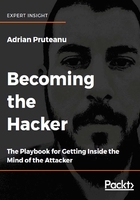
What this book covers
Chapter 1, Introduction to Attacking Web Applications, introduces you to the tools, environments, and the bare minimum ROE we must follow during engagements. We also look at the penetration tester's toolkit and explore cloud as the emerging tool for the web penetration tester.
Chapter 2, Efficient Discovery, walks you through a journey of improving efficiency in terms of gathering information on a target.
Chapter 3, Low-Hanging Fruit, clarifies, emphasizes, and exploits the fact that it is very difficult for defenders to get security right all the time, and many simple vulnerabilities often fall through the cracks.
Chapter 4, Advanced Brute-forcing, discusses brute-forcing in detail, and also explores a couple of techniques for staying under the radar while conducting brute-force attacks during an engagement.
Chapter 5, File Inclusion Attacks, helps you explore the file inclusion vulnerabilities. We also look at several methods to use an application's underlying filesystem to our advantage.
Chapter 6, Out-of-Band Exploitation, looks at out-of-band discovery, exploitation of application vulnerabilities, and setting up a command and control infrastructure in the cloud.
Chapter 7, Automated Testing, helps you automate vulnerability exploitation, including leveraging Burp's Collaborator feature to make out-of-band discovery easier.
Chapter 8, Bad Serialization, discusses deserialization attacks in detail. We dig deep into this vulnerability type and look at practical exploits.
Chapter 9, Practical Client-Side Attacks, covers information relating to client-side attacks. We look at the three types of XSS: reflected, stored, and DOM, as well as CSRF, and chaining these attacks together. We also cover the SOP and how it affects loading third-party content or attack code onto the page.
Chapter 10, Practical Server-Side Attacks, takes you through attacking the server by way of XML, as well as leveraging SSRF to chain attacks and reach further into the network.
Chapter 11, Attacking APIs, focuses our attention on APIs and how to effectively test and attack them. All of the skills you have learned up to this point will come in handy.
Chapter 12, Attacking CMS, looks at attacking CMSs and exploring vulnerabilities with them.
Chapter 13, Breaking Containers, helps you understand how to securely configure Docker containers before deployment with an example of how a compromised containerized CMS led to another container vulnerability that results in full compromise of the host.